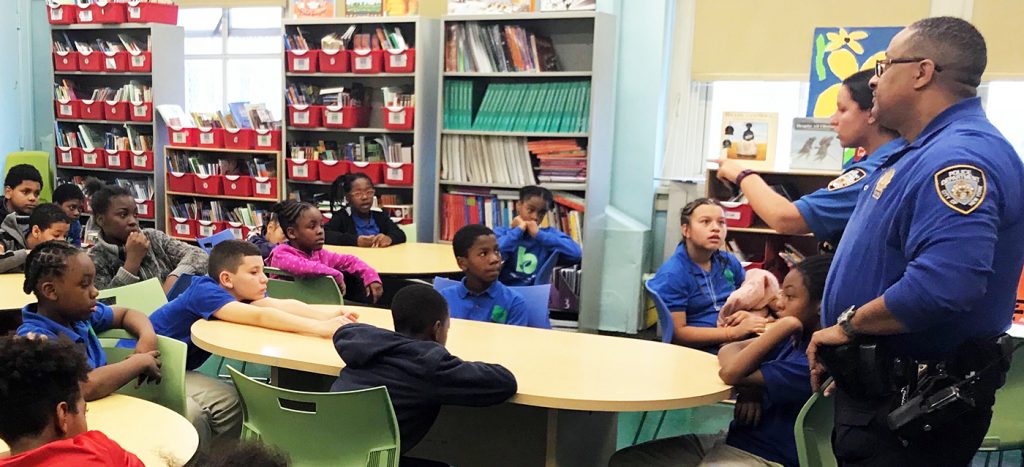
POLICE/COMMUNITY RELATIONS
Eighth graders in Boerum Hill decided to help prevent racially-motivated police misconduct. Through their research, they discovered a critical aspect of this distressing problem, one that often gets less attention. Each year, the New York City Police Department (NYPD) receives 157,000 emergency 911 calls involving New Yorkers struggling with mental and emotional health issues (known as EDPs). Yet, only 13% of NYPD officers receive sufficient training in de-escalating EDP situations. Moreover, the students learned, officers are randomly assigned to distress calls, regardless of their training. After learning that, in 2017 alone, at least 12 New Yorkers struggling with mental health issues were shot by the police, they were adamant that only those NYPD officers who are properly trained should respond to EDP calls. The students organized a petition drive to support an independent task force to address EDP shootings and, to accompany their petition results, wrote impassioned advocacy letters to decision-makers including the mayor and their local City Council member.
Fifth graders in downtown Brooklyn also chose to help improve NYPD/community relations. Deeply distressed by the police-related deaths of Eric Garner and Michael Brown, the students were especially concerned about police bias and inappropriate use of force. After meeting with the Civilian Complaint Review Board and police reform advocates, the class created a Know Your Rights Brochure for NYC youth. Their hope is that the more information young people have, the easier it will be for them to advocate for themselves in a safe and respectful way.
PEER MEDIATION

Middle school students in Red Hook, Brooklyn, concerned about physical conflict between kids and teens in their community, successfully advocated for a school-based peer mediation program. During the Research Phase, they discovered that students who were inclined to resolve conflict through fighting did so either because of external pressure from peers or family members, or because they could not calm themselves down when provoked. The students felt strongly that a peer-led mediation program would provide young people in their community with the tools they need to resolve conflict peacefully. In response to their advocacy presentation, the school administration brought in an outside expert to train students to be effective mediators.
YOUTH COURT
High school students in downtown Manhattan, concerned about disruptive student behavior as well as what they considered an overly punitive school disciplinary system, proposed a school-based Youth Court to improve the school climate. Through Youth Court, students are trained to serve as jurors, judges and attorneys, handling real-life cases involving their peers. The goal is to use positive peer pressure to ensure that young people who have committed minor offenses both pay back the community and receive the help they need to stay out of trouble and succeed in school.
Their school administration agreed to allow the Youth Court to hear cases involving students who were eligible for suspension after violating multiple minor school rules. Youth Court Respondents who completed their sanctions also were invited to become members of the Court.

SLOW ZONE
Concerned about the many traffic accidents involving children in NYC, second graders in Fort Greene joined a local advocacy campaign to slow traffic in their neighborhood. During their research, the students learned that the City Council had declined neighborhood requests to be designated a Slow Zone. To help show widespread demand in the community, the class organized a petition drive for local residents and business owners. They explained the need for a Slow Zone before asking each person to sign their “20 is Plenty” petition. The students also created slower speed limit signs to post in their community and participated in a video campaign produced by a local non-profit.
Access to Public Bathrooms
Second graders in Brownsville chose to advocate for sanitation justice in their community. During the Research Phase, these young advocates became experts in the many challenges created by lack of access to public restrooms, including the particular hardship for youth and the elderly, community members with chronic illnesses, and those without shelter. They learned about the relationship between toilets and human rights, and explored potential solutions by partnering with Phlush, an Oregon-based non-profit advocating for equitable access to public restrooms. To help solve this urgent problem, they created a video call to action for their local city council member, which included a request to install a new public restroom in Brownsville.
DRUNK DRIVING
Fifth graders in downtown Brooklyn were determined to help prevent the devastation caused by dangerous drunk driving. Although driving under the influence is illegal, the punishment is severe, and the risks could not be more serious, close to 30 million people admitted to driving drunk in 2013. Realizing this is not a problem that can be solved by changes in the law, the students decided to organize an awareness raising campaign, specifically targeted at teenagers.
PUBLIC PARK ACCESS & SAFETY
After learning that, due to lead contamination, many local parks had been closed for multiple years, a group of middle and high school students in Red Hook decided to help improve access to parks and recreational space in the neighborhood. Shocked to learn that similarly affected parks in more affluent neighborhoods nearby had been quickly cleaned and reopened years earlier, they organized a multi-faceted advocacy campaign to raise awareness and demand that local legislators expedite the process of cleaning and reopening Red Hook parks. Their campaign included creating an informational website, organizing a social media campaign, and producing a Public Service Announcement (PSA).
Another group of fifth graders in an SLP after-school program were concerned that they had no school playground and the only park in the surrounding neighborhood had fallen into disarray. The class chose to organize a campaign to improve the park, which students in their school used both during recess and after-school. After conducting research and mobilizing the local community, they met with the Commissioner of the Bronx Parks Department who granted their request to adopt and make improvements to the park.